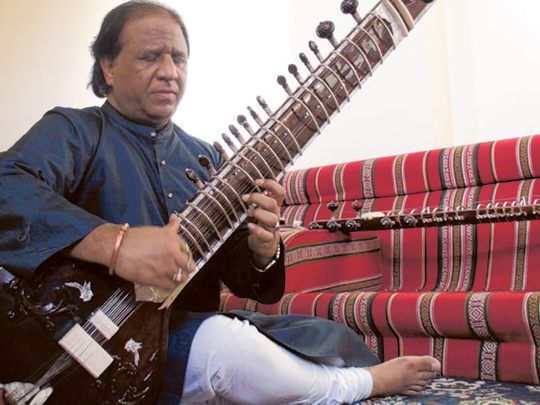
Dubai: Sitar, the famed Indian stringed instrument, can take a lifetime to master.
Yet the resonating, melodious strains of its music, made popular by Ravi Shankar who taught The Beatle’s lead guitarist George Harrison how to play the instrument in the ‘60s, still draw classical music aficionados.
In Dubai, expatriates, mostly Indians, have signed up for sitar classes under Ustad (master) Atta Hussain Khansaheb at the Orient Guest House located in the Al Bastakiya area. The sitar maestro has more than 35 years of experience and has played in concerts across the world, including Singapore, Hong Kong and Cairo. One of his most noted performances is a concert with the iconic Indian classical singer Ustad Ghulam Ali in Delhi, India.
Like playing the guitar, favoured by legendary rockers such as Jimi Hendrix, Keith Richards and Carlos Santana, the left hand of the sitar player has to be free to move up and down the long neck of the instrument.
But that is where, arguably, the similarities stop.
Speaking to Gulf News, Khansaheb said that the first reaction is to equate the sitar to a guitar.
Khansaheb explained that the sitar is played with only two fingers – index and middle, and played up and down and left to right. You cannot move; you sit, cross-legged. The toomba – the large resonator of the instrument made of hollowed and dried pumpkin, rests on the ball of your right foot. You do not wear footwear. In construction, the sitar is complex with either 17 or 19 frets and two levels of strings, and uses a plectrum or picks called mezrab worn on the end of the index finger.
“It is easy to teach the basics of posture, hand position and hand movements in a few classes. Teaching people to play music takes time and involves many hours of practice and dedication,” Khansaheb said, adding that sitar music is traditionally played in north Indian classical music (Hindustani sangeet), film music and Western fusion music.
A desired prerequisite is an understanding of Indian classical music which involves ragas, a set of notes played in different compositions. “Aspiring students need a basic understanding of Indian classical music. However, the lack of it shouldn’t deter someone from taking it up,” Khansaheb said.
As was the case with student Stefan Foldi, a Bulgarian office supervisor with minimum exposure to Indian music. He told Gulf News that he used to sing in a rock ‘n’ roll band. “I have an ear for music and I am deeply interested in Indian music history. I hope to be able to learn the sitar.”
Another student, Baba Yerra, a professor of aviation management, said he took up sitar playing more than 20 years ago but couldn’t pursue it due to lack of sitar teachers.
He told Gulf News, “I’ve had considerable exposure to Western music both singing and playing. I now plan to take sitar lessons seriously and hopefully play in a concert.”
Khansaheb said that one needs to be dedicated to learning the sitar.
“Among the Indian community, there will always be a quest to learn a classical instrument. It is also attracts people from non-Indian classical background.”


